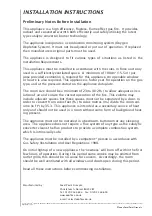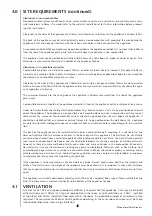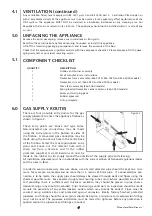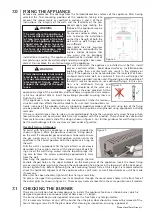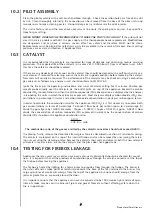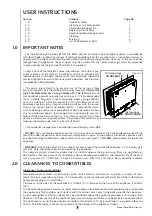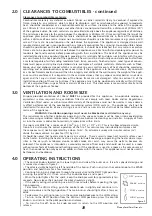
PILOT ASSEMBLY
Clean the pilot assembly with a soft brush and blow through. Check the aeration holes are free of any dirt
or lint. Clean thoroughly internally, the connection can be removed from the base of the pilot unit using
two spanners to make cleaning easier. Do not damage or try to dismantle the pilot injector.
The unit is factory set and the only check necessary is to ensure the spark gap is correct. See specifica-
tions for gas setting.
NEVER MODIFY OR BEND THE THERMOCOUPLE TO MAKE THE PILOT STAY ALIGHT
. If the pilot will not
stay lit there is a problem with dirt, the gas supply, or the thermocouple needs replacement. Modifications
are dangerous and can have a serious unseen effect on safety and therefore MUST not be done.
Replacements must be original manufacturers parts. Re-assemble in the reverse of removal. Ensure setting
pressures are as stated in Section 2; Appliance Data.
CATALYST
It is recommended that the catalysts are inspected for signs of damage and dirt during routine servicing
procedures. The expected life of the catalysts is in excess of 11,000 hours (10 years of normal use). After
this time the catalysts should be replaced.
If there are any deposits of dirt or soot on the catalyst they should be cleaned with a soft brush and a vac-
uum cleaner. If removed for cleaning ensure the seals are in good condition before replacing the catalyst.
New seals will usually be required. The performance of the catalysts may be checked using a combustion
gas analyser as follows. Any analyser used should conform to EN 50379-3.
Ignite the fire as per the operating instructions, and run at maximum setting for 15 minutes. Position gas
sample probe directly over the catalysts via the outlet grille, on top of the appliance. Record the carbon
dioxide (CO2) concentration and then the carbon monoxide (CO) concentration as displayed by the analyser
- also noting the units in which the values are expressed. Most analysers display carbon dioxide (CO2) con-
centrations in percentage (%) terms and carbon monoxide concentration in parts per million (ppm) terms.
In order to calculate the combustion ratio for the appliance (CO/CO2) it is first necessary to express both
gas concentrations in terms of percentage. To convert from parts per million (ppm) to a percentage (%)
divide the ppm figure by 10,000. Examples : 35ppm = 0.0035%, 15ppm = 0.0015%, 5ppm = 0.0005%. Now
divide the concentration of carbon monoxide (CO) expressed in percent by the concentration of carbon
dioxide (CO2) to obtain the appliance combustion ratio.
The combustion ratio of the gasses emitted by the catalytic convertor should not exceed 0.0015.
If replacing, firstly, remove the decorative frame/glass facia (as described in section 8.3) and outer casing.
The catalysts are located on the top of the internal firebox and can be removed by unscrewing the retain-
ing nuts securing the clamping plates. Remove the catalysts their seals and discard. Refit the new catalysts
and seals in reverse order, ensure the catalysts and the glass door have good seals.
TESTING FOR FIREBOX LEAKAGE
Appliances that are several years old or have been extensively dismantled should be checked for sound-
ness. It is important that all the products of combustion pass through the catalytic converter at the top of
the firebox before leaving the appliance.
The firebox is heated by lighting for a few minutes to provide a flow through the firebox. The burner is
then shut off and a smoke pellet or match introduced at the base of the fire underneath the burner tray.
Large quantities of smoke will emerge from the top of the appliance, but none should emerge from the
joints or gasket faces, especially around the door.
It is important to note that the appliance can never be expected to be 100% smoke tight and small quan-
tities of smoke may be seen in corners of joints and gasket faces etc without affecting safety when the
fire is in operation.
9
CO (%)
CO2 (%) = ratio
10.4
10.3
10.2
©
2009 Focal Point Fires plc.



